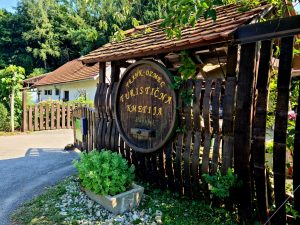I’m old enough to fess up to a number of obsessions, one of which is statues. They fascinate me on two levels: what they represent and what they’re supposed to represent. In this regard, spending a few days in Skopje was like spending a few days touring with Dara O’Briain – it was one jaw-dropping surprise after another.
I was particularly amused by the statue of Prometheus that sits in a park across from the Parliament building. It’s part of a ‘statue complex‘ that has three parts representing the world of the living and a passage to the world of the gods. Prometheus, the god who brought us fire, stands in the middle of an agora representing heroic sacrifice. On top of the doorway to eternity stand four horses. And atop a marble pillar stands a winged goddess of victory. Somewhere in there is what was intended to be an eternal flame, but it was doused when the park’s young visitors started to use it to barbecue their sausages. What amused me was the fact that Prometheus was first erected in all his glory but politicians caved to public indignation and had him clothed. Mind you, the story I heard was that the politicians themselves didn’t like looking out the windows of Parliament at a god in all his golden glory. Whether it was unidentified women’s organisations that lobbied for the loin cloth, or the politicians themselves that had the god clothed, the mind boggles at such inanity.

Next on my list is a statue of someone whose name escapes me. It caught my attention because of the controversy the project has ignited. The public is a tad upset at the millions of euro being spent on these statues and there are murmurs that not all the money might be going where it should have gone. This chap, putting away what might be a wallet, screamed corruption at me. Apparently, the night of the mayoral election in the Centar municipality, the incumbent was defeated. At 3am he got to work. By 8 am the next morning, the two boys had taken up their positions on either side of the Porta Macedonia, a triumphal arch that stands 21 meters tall and itself cost €4.4 million. Apparently, the defeated Mayor promptly sent the bill to his successor. Payback’s a bitch alright.
Across the Stone Bridge sits Karpoš’s Rebellion Square. In one of three fountains sit four statues of four women in various stages of motherhood. Titled the Fountain of the Mothers of Macedonia, it depicts a pregnant woman, a woman breastfeeding, a woman playing with her son, and another of what seems to be her protecting him. In the background stands the Warrior monument, generally believed to be a statue of Philip II of Macedon – Alexander the Great’s father. At this stage, the penny dropped. Macedonia is really hammering it home to Greece that its claim on the name Macedonia is greater – but subtly, of course. Not surprisingly, the mothers of Macedonia are thought by some to depict one mother – and represent the early stages of Alexander’s life.
Sitting in the centre of Macedonia Square is the statue of the Warrior on a Horse, generally believed to be that of Alexander the Great. The relatively unknown sculptor is said to have received €650 000 while the whole fountain cost about €9 million. It lights up at night and it plays music, too. Apparently the people cried with joy when it was raised… but the tears I heard were more of despair. It would seem that this statue frenzy has divided the city more so that the River Vardar already does.
While I was thinking of this despair, I happened across this sculpture which at first I took to be a lifesaving in motion. But then I realised it was a diving platform. I liked it. Clever I thought. And a break from the greatness of the other monuments with their innocuous titles and their subtle implications.
And then I found some light relief down by the National Theatre. Not unlike Budapest’s National Theatre, it too has a series of statues of great actors but even they seem to be enjoying a certain amount of self-deprecation. This one was my favourite. Sass and style and a dare-to-be-different attitude that might well sum up Skopje. The jury is out.
Is Macedonia’s capital being turned in to a theme park, as the CNN article ran? Or it is a ploy to distract the nation from its real problems: high unemployment, poverty and stalled progress towards EU and NATO membership. New-York-based Macedonian architect Robert Dandarov reckons that Skopje has turned into ‘an encyclopedia of kitsch’. Me, I’m just glad I got to see it all and marvel.
Share this:
- Click to share on X (Opens in new window) X
- Click to share on Facebook (Opens in new window) Facebook
- Click to share on Pinterest (Opens in new window) Pinterest
- Click to share on LinkedIn (Opens in new window) LinkedIn
- Click to share on Reddit (Opens in new window) Reddit
- Click to share on WhatsApp (Opens in new window) WhatsApp
- Click to share on Pocket (Opens in new window) Pocket
- Click to share on Telegram (Opens in new window) Telegram
- Click to email a link to a friend (Opens in new window) Email













4 responses
Thanks, the more I see of that place the more I’m suprised that I hadn’t pick up on the place before………facinating. The links at the end make for interesting reading, particulary the comments assocaited with those links.
Watch for Sunday’s post – you’ll love that one Peter – will be interested to hear your comments….
Do any of the statues move, like in Ireland?
In a weird way, they do… there’s one with horses in a fountain and when the water comes one, it really looks as if the horses are trying to jump out…